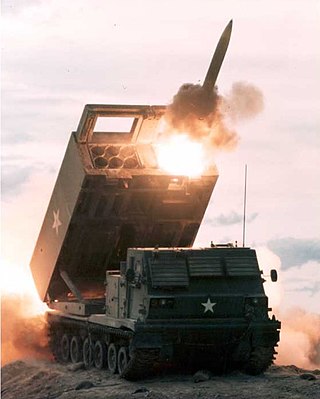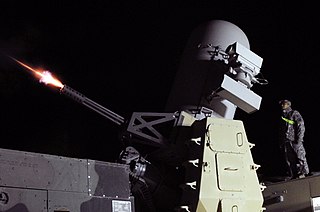
Artillery are ranged weapons that launch munitions far beyond the range and power of infantry firearms. Early artillery development focused on the ability to breach defensive walls and fortifications during sieges, and led to heavy, fairly immobile siege engines. As technology improved, lighter, more mobile field artillery cannons developed for battlefield use. This development continues today; modern self-propelled artillery vehicles are highly mobile weapons of great versatility generally providing the largest share of an army's total firepower.
Ram, ram, or RAM most commonly refers to:
A centurion was a professional officer of the Roman army.
M2, M-2, M.2 or M02 may refer to:
Counter-battery fire is a battlefield tactic employed to defeat the enemy's indirect fire elements, including their target acquisition, as well as their command and control components. Counter-battery arrangements and responsibilities vary between nations but involve target acquisition, planning and control, and counter-fire. Counter-battery fire rose to prominence in World War I.

A counter-battery radar or weapon tracking radar is a radar system that detects artillery projectiles fired by one or more guns, howitzers, mortars or rocket launchers and, from their trajectories, locates the position on the ground of the weapon that fired it. Such radars are a subclass of the wider class of target acquisition radars.

Rocket artillery is artillery that uses rockets as the projectile. The use of rocket artillery dates back to medieval China where devices such as fire arrows were used. Fire arrows were also used in multiple launch systems and transported via carts. The first true rocket artillery was developed in South Asia by the Tipu Sultan the ruler of the Kingdom of Mysore. In the late nineteenth century, due to improvements in the power and range of conventional artillery, the use of early military rockets declined; they were finally used on a small scale by both sides during the American Civil War. Modern rocket artillery was first employed during World War II, in the form of the German Nebelwerfer family of rocket ordnance designs, Soviet Katyusha-series and numerous other systems employed on a smaller scale by the Western allies and Japan. In modern use, the rockets are often guided by an internal guiding system or GPS in order to maintain accuracy.

The 16th Regiment, Royal Australian Artillery is the Australian Army's only ground-based air defence (GBAD) unit. It also provides sense, warn and locate, ground liaison, and joint terminal attack control capabilities. Part of the Royal Regiment of Australian Artillery (RAA), the regiment is responsible for protecting a wide range of military assets during wartime, ranging from Army units in the field to providing point defence to the Royal Australian Navy's support ships and air defence to Royal Australian Air Force air bases. Prior to being equipped with the currently in-service RBS 70 surface-to-air missile system, the regiment was equipped with the Rapier systems for 25 years. The regiment is based at Woodside, South Australia, but frequently deploys with other Australian and allied units on operations and defence exercises. The regiment is part of the 6th Combat Support Brigade.

The Israeli Air Defense Command is the Israeli Air and Space Force unit responsible for the surface front of Israels air defense, complementing the air defense provided by Fighter squadrons. Initially a part of the IDF Artillery Corps, since 1970 the Air Defense Command has been subordinate to the Israeli Air and Space Force.

ARTHUR is a counter-battery radar system originally developed jointly for and in close co-operation with the Norwegian and Swedish armed forces by Ericsson Microwave Systems in both Sweden and Norway. It is also used by the British Army, under the names mobile artillery monitoring battlefield radar or mobile artillery monitoring battlefield asset (MAMBA).

Counter rocket, artillery, and mortar, abbreviated C-RAM or counter-RAM, is a set of systems used to detect and/or destroy incoming rockets, artillery, and mortars before they hit their targets, or provide early warning.

16 Regiment Royal Artillery is a regiment of the Royal Regiment of Artillery in the British Army. It currently serves in the Ground Based Air Defence role and is equipped with the Sky Sabre air defence missile system and Land Environment Air Picture Provision (LEAPP).

MANTIS Air Defence System, formerly titled NBS-C-RAM, is a very short range air defence protection system of the German Air Force, intended for base-protection. It is produced by Rheinmetall Air Defence, a subsidiary of Rheinmetall of Germany. It is a part of the air force's future SysFla air-defence project.
Type 10 is a main battle tank used by the Japan Ground Self-Defense Force.
The SkyKnight is an all-weather multi-target short-range air defence missile. It was developed by Halcon Systems and is the United Arab Emirates' first designed counter-rocket, artillery, and mortar (C-RAM) missile. SkyKnight is planned to be integrated into Rheinmetall Skynex air defence system. Skynex is a fully networked system of sensors and effectors linked via a tactical communications network to provide a mostly automated layered defence against various aerial threats. Up to four 6.1 m (20 ft)-long SkyKnight missile launcher units (MLU) with 60 rounds each can be controlled in a Skynex battery. An MLU can launch up to five missiles in one second and each can simultaneously fire 20 at one time to neutralize 80 incoming targets. The missiles are capable of intercepting manned and unmanned aircraft and helicopters at 10 km (6.2 mi), precision guided munitions (PGMs) and cruise missiles at 6 km (3.7 mi), and RAM projectiles at 4 km (2.5 mi). The Skynex system combines the SkyKnight with up to four Oerlikon Revolver Gun Mk3 35 mm revolver cannons to handle anything that penetrates through the missile defenses.

The Land Phalanx Weapon System (LPWS), often called C-RAM, or Centurion C-RAM is an American air defense artillery system. The system was developed in 2004, during and after the Iraq War identified a weakness in ground-based anti-projectile artillery. The system is produced by Northrop Grumman, Raytheon, and Oshkosh Corporation.
This page is based on this
Wikipedia article Text is available under the
CC BY-SA 4.0 license; additional terms may apply.
Images, videos and audio are available under their respective licenses.









